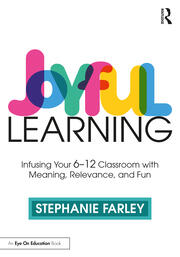Lessons Learned from Gifted Neurodiverse Kids
By Stephanie Farley

He was a child actor, comfortable with adults and able to chit chat informedly about all sorts of matters, from pop stars and the best place to get a taco in LA to the Revolutionary War and modern politics.
Charming and witty, Jesse was an ideal student: he made connections other students didn’t have the background knowledge to make, and he backed up his Wikipedia-like knowledge with humor and humility.
At lunch one day, my wise and lovely colleague saw Jesse pass by and said, “Jesse’s just so smart. He makes me a better teacher. When I look over at him and see he’s bored, I know everyone is bored and I’ve got to change tactics.” She was right. Jesse required both of us to seriously step up our teaching game.
As it turned out, Jesse wasn’t just smart in the “bright kid” way, he was gifted. He could read at college level, remember all that he read and all that was said to him, process information in seconds, and find novel solutions to all sorts of problems. He was a walking marvel of human consciousness.
Oh, and Jesse also had ADHD.
Facilitating learning for all kids, including the neurodiverse and gifted
I’ve been thinking often lately about Jesse and other students like him. This year I’m working with a school whose population is gifted and neurodiverse. And what was true in the days of low pants is still true now: these learners make us raise our game as teachers, which benefits everyone.

There is an incredible range of diversity in what is meant by “neurodiverse.” Managing these varying learning profiles in one classroom can seem daunting, but we become much more effective teachers when we embrace the need to facilitate learning for all kinds of kids – including those who are both profoundly gifted and find writing super challenging.
When I talk with the teachers at the school I’m working with this year about their practice, the first word they mention is flexibility. They mean flexible in every possible sense: their own ability to adjust lessons to suit the evolving needs of the kids; the flexibility to help students reframe events and emotions so they can move forward; and the willingness to change guidelines (i.e., due dates or requirements) to meet students where they are.
Here are three flexible instruction approaches I’ve used that include gifted and neurodiverse learners:
1. Plan for Choice
Plan every lesson, assignment, and activity with a range of choices, as choice is the pathway to differentiation. Having Jesse in my class forced me to put aside activities that were fine, but not captivating. At the same time, I couldn’t just plan a lesson for Jesse, as it would be at a level well beyond what most of my students could manage.
This is when I started creating choices for every single activity…choices that weren’t just about the medium or the research, but about the depth and complexity of work. For example, for an assignment in which I wanted students to demonstrate an understanding of a book’s big idea and details – with a side of synthesis where possible – I provided three choices of work product:
a. Selecting a passage from the book under study, highlighting the big idea and supporting details in the passage, then writing a paragraph explaining the significance of the passage to the overall story.
b. Drawing a picture of a pivotal moment in the book, including both details as described by the author and details the reader imagined, all labeled. This drawing would need to be explained orally (or audio recorded).
c. Annotated fan fiction: students who chose this option had to write fan fiction about the book under discussion, annotating the prose to note where their fiction synthesized the original work with their analysis of big idea and detail.
The choice that offered the most depth and complexity was “c,” as this assignment required students to not only apply their knowledge of the book but to extend it by writing fan fiction, then synthesizing by showing the connections between what they wrote and the author’s original work.
My students who struggled to write could draw and explain, while my students who struggled to synthesize could simply analyze what was written and explain it.
If these three choices didn’t appeal to a student, I’d work with them to create an assignment that met the learning targets while hitting on the student’s preferred methodology.
2. Use Emotions
Use the power of positive emotions like curiosity, wonder, and awe to open your lessons. When you frame your lesson with an engaging, positive-emotion-laden activity, all students are primed for learning. Lots of teachers use “warm-ups,” which is a good start, but to really maximize the time I suggest layering novelty, wonder, and adventure into your opening.
While I love stunts to frame my lessons – like live animals, staged fights, and unannounced guests – you don’t have to go big or go home. You can introduce adventure by asking students to find materials they need for that day’s project that you’ve hidden outside or by taking an “awe walk,” in which you lead students around the campus for 10 minutes, asking them to take note of everyday pleasures they encounter, like a perfectly adorable bumblebee or the jagged yet soft edges of a leaf.

There are a few decades of research to support the notion that positive emotions help students focus and engage (Frederickson). Further, positive emotions increase emotional regulation and improve our sense of well-being (Baumeister et al; Frederickson; Tice et al; Tugade et al). This strategy is particularly useful for students who are gifted and neurodiverse, as a surprising, adventurous, awesome opening activity not only snags the students’ attention in the first place, but it widens the aperture of their attention, allowing them to engage more deeply over a longer period of time.
I found that when I’ve had an effective opening – when I’ve managed to capture every single student’s focus – I don’t have to repeat directions as frequently, because the kids are so invested that they listen and process for those five minutes of instruction! Major win!
Using positive emotions in the beginning of class also just makes kids feel capable and competent, which is exactly how you want them to feel…like no matter how they show up, each student can be successful in your classroom.
3. Flex Your Routines
Finally, be aware of the routines you’re creating and examine them to ensure those routines serve every student. I’ve noticed that little tweaks can bring freshness and zest back into the class when some routines get stale.
While the idiom “if it ain’t broke, don’t fix it” exists for a reason, it’s also true that some of our students – especially those with attention issues and those who seek challenge – thrive on novelty. It’s a delicate balance, to be sure, but that’s why framing activities are so effective and why carefully examining the choices you’ve provided is key.
It’s such a gift (pun intended) to teach learners like Jesse, who certainly taught me as much as I taught him. I learned how to be more flexible, more conscientious about front-loading differentiation so that I didn’t unintentionally call out anyone or make them feel different (a demotivating force for middle school students!), and more determined to engage every single learner in my classroom.
After 29 years as an educator, one thing I know to be true is that gifted, neurodiverse students make us better teachers for everyone. I’d love to hear your stories of students who shifted your teaching practice!
References
Baumeister RF, Vohs KD, Tice DM. “The Strength Model of Self-Control”. Current Directions in Psychological Science. 2007;16(6):351-355.
Frederickson, Barbara L. “The Role of Positive Emotions in Positive Psychology.” American Psychologist, March 56:3, 218-226, 2001.
Tice, Dianne M., Baumeister, Roy F., Shmueli, Dikla, Muraven, Mark. “Restoring the self: Positive affect helps improve self-regulation following ego depletion.” Journal of Experimental Social Psychology, Volume 43, Issue 3, 2007:379-384, ISSN 0022-1031.
Tugade, Michele M. and Frederickson, Barbara L. “Regulation of Positive Emotions: Emotion Regulation Strategies that Promote Resilience”, Journal of Happiness Studies, 8:311-333, 2007.

Stephanie’s first book is Joyful Learning: Tools to Infuse Your 6-12 Classroom with Meaning, Relevance, and Fun (Routledge/Eye On Education, 2023). She has created professional development for schools around reading and curriculum and coaches teachers in instruction, lesson planning, feedback, and assessment. Visit her website Joyful Learning and find her other MiddleWeb articles here.
































Beautifully stated with easy to implement, practical ideas. I had these students, and I love this piece!!